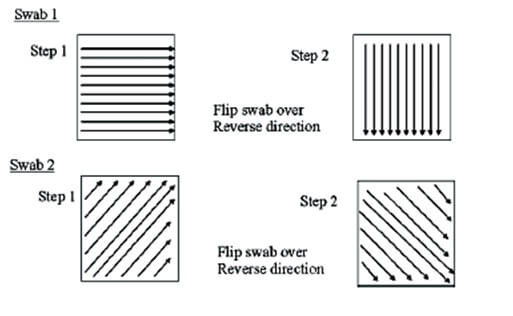Validation relies on meticulous and accurate testing. When swabbing for residue samples, follow this advice for reproducible results.
If you consider cleaning validation a three-step process, it will involve 1) cleaning/rinsing of necessary surfaces, 2) sampling any residues left behind after step 1, and 3) analyzing your samples. The greatest challenge in this 3-step process is ensuring that step two is carried out in a highly reproducible manner. If it isn’t, the analysis won’t truly represent the condition of the sampled surface.
To accomplish reproducibility, you want to focus on four things:
- Thorough completion of step one
- Use the proper swab
- Wet the swab correctly
- Swipe the area consistently
The first step above is rather obvious. If you can actually see particles on any surface, you need to clean it. The residues you’re testing are invisible to the naked eye. Moving on to the second area of focus, the best swab for sampling will be made from laundered polyester knit fabric. This material releases the fewest particles, has the highest recovery, and provides the lowest background when TOC measurements are employed.
With the right swab in hand, in order to sample, the swab needs to be moistened. If you merely saturate the swab head with high-quality water, excess liquid will spread residue over the surface rather than collect on the material. The swab should be damp but not saturated. After immersing the head into a container of high-quality water, simply press both sides of it against the inside of the container to release trapped air. Draw both swab head sides across the rim of the container to expel excess liquid.
Once properly moistened, you want to use a consistent swabbing pattern. The area you’re sampling will usually be 5cm by 5 cm. Then use the following pattern:
- Swipe the first side of the swab horizontally ten times over the sampling area.
- Flip the swab and swipe the other side ten times vertically over the area.
- Deposit the swab into a collection vial.
- Use the first side of a second swab to swipe the same area diagonally upwards ten times.
- Flip the swab over and swipe diagonally downwards ten times.
- Deposit the second swab into the same collection vial.
The figure below shows the swiping pattern. It is taken from the cemag.us.com article “How To Succeed In The Search For Nothing: Effective Swabbing Techniques For Cleaning Validation” by Wendy Hollands, Howard Siegerman, Ph.D., Michael Strauss.
Proper swabbing techniques will ensure that you get accurate results. For other questions about validation or cleanroom certification, contact Gerbig Engineering Company. We have 30 years of experience delivering expert cleanroom services. Call 888-628-0056 or email info@gerbig.com today.
